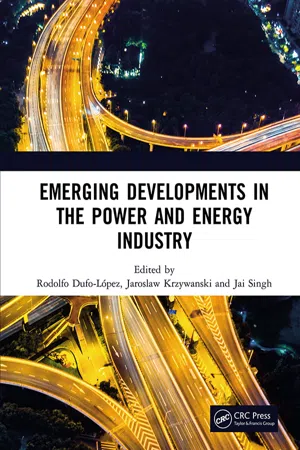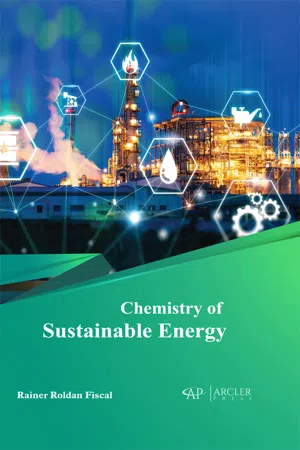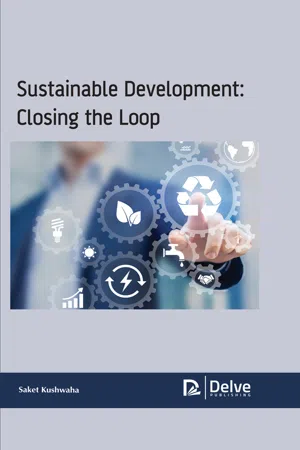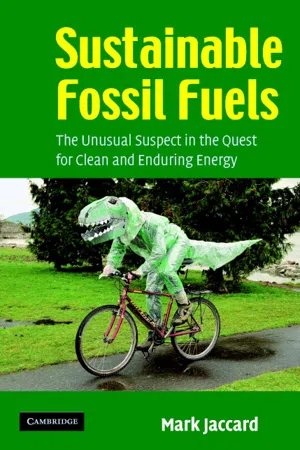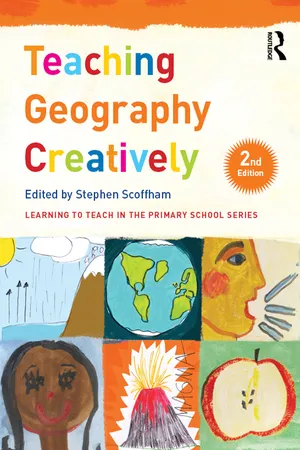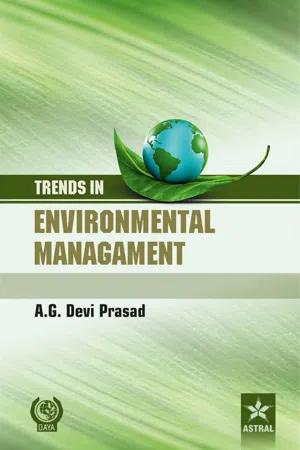Geography
Sustainable Energy
Sustainable energy refers to energy sources and practices that meet present needs without compromising the ability of future generations to meet their own needs. It involves using renewable resources such as solar, wind, and hydroelectric power, as well as promoting energy efficiency and reducing environmental impact. Sustainable energy aims to minimize the depletion of natural resources and reduce greenhouse gas emissions.
Written by Perlego with AI-assistance
Related key terms
1 of 5
8 Key excerpts on "Sustainable Energy"
- eBook - PDF
Emerging Developments in the Power and Energy Industry
Proceedings of the 11th Asia-Pacific Power and Energy Engineering Conference (APPEEC 2019), April 19-21, 2019, Xiamen, China
- Rodolfo Dufo-López, Jaroslaw Krzywanski, Jai Singh(Authors)
- 2019(Publication Date)
- CRC Press(Publisher)
3.1 Sustainable development Sustainable Energy is the energy that, in its production or consumption, has minimal negative impacts on human health and the healthy functioning of vital ecological systems, including the global environment. It is an accepted fact that renewable energy is a sustainable form of energy, which has attracted more attention during recent years. Increasing environmental interest, as well as economic consideration of fossil fuel consumption and high emphasis of sustainable development for the future helped to bring the great potential of renewable energy into focus Wu, and Boggess (1999). Nearly a fifth of all global power is generated by renew-able energy sources, according to a new book published by the Organisation for Economic Co-operation and Development (OECD)/International Energy Association (IEA) OECD/IEA (2004). ‘‘ Renewables for power generation: status and prospects ’’ claims that, at approxi-mately 20%, renewables are the second largest power source after coal (39%) and ahead of nuclear (17%), natural gas (17%) and oil (8%) respectively. From 1973-2000 renewables grew at 9.3% a year and it is predicted that this will increase by 10.4% a year to 2010. Wind power grew fastest at 52% and will multiply seven times by 2010, overtaking biopower and hence help reducing green house gases, GHGs, emissions to the environment. 4 RESULTS AND DISCUSSIONS The availability of data on solar radiation is a critical problem. Even in developed countries, very few weather stations have been recording detailed solar radiation data for a period of time long enough to have statistical significance. Solar radiation arriving on earth is the most fundamental renewable energy source in nature. It powers the bio-system, the ocean and atmospheric current system and affects the global climate. - eBook - PDF
- Rainer Roldan Fiscal(Author)
- 2020(Publication Date)
- Arcler Press(Publisher)
Government from various countries all around the world and on all continents is setting impressive targets for renewable energy, with an ever-growing number of jurisdictions aspiring for 100% of renewables. Local governments, in particular, are backing up this movement and are becoming incubators of locally suitable best policies and practices. Global Perspective on Energy and Sustainable Development 205 The noteworthy engagement of renewable energy has been driven primarily by a variety of objectives (drivers) that incorporate advancing economic growth, augmenting energy access, comprehensive energy security, and alleviating climate change. Altogether, these drivers might be defined as the quest of sustainable development , where economic affluence is advanced across the world while negative impacts are minimized. While such notable advantages are extensively cited as key drivers in energy and political debates, specific, documented evidence of such advantages remains rather restricted for reasons involving a lack of acceptable conceptual frameworks, methodological confronts, and partial access to relevant data. 8.2. ENERGY SUSTAINABILITY Figure 8.1. Cleaner energy. Sources: Pixabay. In some ways, the energy sustainability concept is generally the application of the typical definitions of sustainability to energy. In other ways, energy sustainability is more intricate and involved (Figure 8.1). Energy sustainability basically refers to the inclusion of energy services in a sustainable manner, which in turn demands that energy services be provided for all people in ways that, in present as well as in the future, are adequate to provide basic necessities, affordable, acceptable to people and communities, and having no negative impact to the environment. Chemistry of Sustainable Energy 206 There has been not, yet any universal definition of energy sustainability defined, but various descriptions and definitions have been presented. - Majid Nayeripour, Mostafa Kheshti, Majid Nayeripour, Mostafa Kheshti(Authors)
- 2011(Publication Date)
- IntechOpen(Publisher)
Such degradation on a global scale could imply extinction for humanity. 6. Conclusion There is an intimate connection between energy, the environment and sustainable development. A society seeking sustainable development ideally must utilize only energy resources which cause no environmental impact. Clearly, a strong relation exists between energy efficiency and environmental impact since, for the same services or products, less resource utilization and pollution is normally associated with increased energy efficiency. Sustainable Energy is the provision of energy that meets the needs of the present without compromising the ability of future generations to meet their needs. Sustainable Energy sources are most often regarded as including all renewable energy sources, such as hydroelectricity, solar energy, wind energy, wave power, geothermal energy, bio-energy, and tidal power. It usually also includes technologies that improve energy efficiency. Renewable energy technologies are essential contributors to Sustainable Energy as they generally contribute to world energy security, reducing dependence on fossil fuel resources and providing opportunities for mitigating greenhouse gases. As such, Sustainable Energy promotes sustainability. Sustainability, here, is twofold, as it constitutes self-sustenance and the ability to foster sustainable development. By being self-sustaining the energy source is in essence limitless. Solar energy, wind energy, geothermal energy, hydropower and biomass are all self-sustaining. They all have sources that cannot be depleted. These energy sources allow for the conservation of other energy sources, like trees that would have been used for charcoal production. Using these renewable energies also encourages the protection of the environment which traditional energy sources have helped to destroy. The use of some traditional energy sources, like oil and charcoal, the Natural Resources Conservation Authority (NRCA) reported carries with- eBook - PDF
- Saket Kushwaha(Author)
- 2020(Publication Date)
- Delve Publishing(Publisher)
Lawful principles; very much educated customers, organizers, and leaders; persuaded operators; and a sufficient installment framework for energy is fundamental to the fruitful Energy and Sustainable Development 91 usage of energy effectiveness enhancements (Darnell and Jefferson, 1994; Cowan, 1997). 3.7. RENEWABLE ENERGY (RE) TECHNOLOGIES Sustainable power sources (counting biomass, wind, solar, hydropower, and geothermal) that utilizes indigenous assets can furnish energy services with zero or right around zero outflows of both air poisons and greenhouse gases. Right now, sustainable power sources supply 14% of the all-out world energy demand. The inventory is commanded by traditional biomass utilized for cooking and warming, particularly in the provincial areas of developing nations. Huge scope hydropower supplies 20% of worldwide power. Its degree for development is constrained in the industrialized world, where it has almost arrived at its financial limit. In the developing world, significant potential despite everything exists, except huge hydropower; undertakings may confront financial, ecological, and social constraints. By and large, new sustainable power sources contributed 2% of the world’s energy utilization in 1998, including 7 exajoules from present-day biomass and 2 exajoules for all different renewables (geothermal, wind, solar, and marine energy, and small-scale hydropower). Sun oriented photovoltaics and grid-connected wind introduced capacities are developing at a pace of 30% a year. All things being equal, it will probably be a very long time before these new renewables signify a significant part of all-out vitality utilization since they as of now speak to such a little rate (York, 1994). Considerable value decreases in the previous decades have made some renewables competitive with non-renewable energy sources in specific applications in developing markets. - eBook - PDF
Sustainable Fossil Fuels
The Unusual Suspect in the Quest for Clean and Enduring Energy
- Mark Jaccard(Author)
- 2006(Publication Date)
- Cambridge University Press(Publisher)
They also use more of the earth’s surface – land and water – for living space, recreation, and the production and disposal of materials. Our efforts toward a more Sustainable Energy system do not ensure sustainability in a holistic sense, but they can make an important contribution. The goal of sustainability requires profound changes to the material and energy flows associated with humanity in that these flows cannot result in the accumulation of disruptive substances or excessive waste heat in the biogeophysical system. The technologies and resource uses that achieve this objective for the energy system could be equally applicable to controlling material flows related to agriculture, mining, forestry, fisheries and the inputs and waste out- puts from urban areas. Human economies will need to evolve toward closed-loop principles that are currently identified with concepts such as industrial ecology, biomimicry and environmental life-cycle management. All of these imply that the inputs and outputs of human activity are designed and controlled to ensure that these flows are non-disruptive to the earth’s biogeophysical system, including the maintenance of biodiversity. Is Sustainable Energy sustainable? 325 The policy designs for a more Sustainable Energy system are equally applicable to the broader sustainability objective. Just as the energy system requires tighter controls over the uses of land and water, and the rehabilitation of these where activities entail some degree of unavoid- able disruption, so too will other activities require this. In some loca- tions, this will involve severe restrictions on any human activity whatsoever – in effect, allowing natural systems to evolve as they would without human interference. - eBook - PDF
- Stephen Scoffham(Author)
- 2016(Publication Date)
- Routledge(Publisher)
While values and emotions are intrinsic and inescapable facets of sustainability, being properly equipped to respond to these issues also demands some degree of cognitive understanding about how and why human, biological and physical worlds interact with and affect each other. This is part of the remit of geography education. Melding these ingredients together successfully to produce new ways of thinking about the world and some of the daunting issues we face, requires creativity of approach, thought and deed. TEACHERS’ KNOWLEDGE OF EDUCATION FOR SUSTAINABILITY Research by Symonds (2008) found that the majority of teachers had limited knowledge of ESD and that it was often piecemeal and impacted only on small groups of pupils. Surveys by Ofsted (2008, 2009) reveal that sustainability education is more noticeable in PAULA OWENS n n n n n 178 primary than secondary schools. However, this finding is tempered by the observation that ‘while a small number of schools were doing this well, many schools were only doing this as a peripheral activity and not through the mainstream curriculum’ (Ofsted 2008: 5). With respect to geography, Ofsted (2011) raised concerns about the quality of teach- ing and the amount of time allocated to it. Unfortunately, a climate of poor geography teaching does not bode well for successful work on sustainability. As Martin and Owens (2010: 9) note, ‘if you are doing ESD then you’re probably doing geography!’ Imagine, for example, trying to teach about sustainability without understanding how local and global events are connected or how human, physical and environmental processes inter- act. If we need to improve ESD, we also need to improve the teaching and learning of geography. A survey by WWF (2010) into pedagogical approaches to sustainability found that success was dependent on teachers’ subject knowledge; the support structures in schools; and teachers’ capacity to root learning within the knowledge and skills of the curriculum. - eBook - PDF
Sustainable Development
An Appraisal from the Gulf Region
- Paul Sillitoe(Author)
- 2014(Publication Date)
- Berghahn Books(Publisher)
Coal, oil and gas are themselves the remains of living organisms, and their energy content ultimately derives from photosynthesis, but is bound up in matter that has been sequestered in the earth’s crust and transformed by geological processes over timescales measured in aeons. In those parts of the world that have experienced industrialization, 1 these 136 | Thomas Henfrey products of previous geological eras, along with nuclear fission, power all of the processes necessary for survival and well-being: food production, manufacturing, transportation, construction, the maintenance of basic in-frastructure and the habitability of buildings. Abundant reserves of these fuels have brought Qatar and other Gulf states to an important role in the global economy. This role may become more important still as the world prepares for another shift, away from fossil fuel dependency and towards the sustainable use of renewable energy sources. Energy, Society and Culture Energy’s central role in all human societies means our relationship with it is at the heart of sustainability. This is particularly so in the industrial-ized world, whose appropriation, transformation and use of energy are afflicted with a chronic lack of sustainability. This is true both directly, in that we rely overwhelmingly on primary energy sources that are in inher-ently limited supply, and indirectly, in that use of these energy sources has deleterious environmental and social impacts. The combined impact has in recent decades reached such a magnitude that, on a global scale, another revolutionary transformation of our relationship with energy is inevitable (Abramsky 2010). This may occur by choice, through pre-emp-tive measures that seek to minimize, and eventually eliminate, the social and environmental costs of the ways we currently capture, transform and use energy. - eBook - PDF
- Prasad, A G Devi(Authors)
- 2021(Publication Date)
- Daya Publishing House(Publisher)
Chapter 7 Energy Resource Management for Sustainable Utilization A.G. Devi Prasad andH.P. Komala DOS in Environmental Science, University of Mysore, Manasagangotri, Mysore-06, Karnataka ABSTRACT Energy is one of the most important inputs for economic growth and human development, this paper describes the different types of energy and their consumption and utilization trend in India. India is world’s 7 ,h largest energy producer and 5 th largest energy consumer. Due to the immense demand for energy within the country dissemination of Sustainable Energy becomes the need of the hour. Despite the financial, political and technical constraints, utilization of Sustainable Energy has to be encouraged as it provides enormous benefits from ameliorating adverse impacts on environment to improve livelihoods of peasant’s. Biomass, an important energy source, contributes in substituting the fossil fuels, especially in developing countries. To cater the biomass demand, more land area has to bring under cover, which would help the rural population. Prioritization of development of renewable energy sources help in self-sustenance of energy sources. Key words: Biomass, Renewable, Consumption, Management, Electricity Introduction Energy is one of the most important inputs for economic growth and This ebook is exclusively for this university only. Cannot be resold/distributed. human development in raising the standard of living and quality of life. It has an influencing role in the development of key sectors of economic importance such as industry, transport and agriculture. This has motivated many researchers to focus their research on energy management (Singh, 1999; Baruah and Bora, 2008). It is a kind of strategic resource and an important substantial basis for economic increase and social development (Arevalo et al., 2007; Shao and Chu, 2008). Per capita energy consumption is an index of growth of any nation in all forms of inputs.
Index pages curate the most relevant extracts from our library of academic textbooks. They’ve been created using an in-house natural language model (NLM), each adding context and meaning to key research topics.
